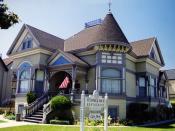Throughout history, man has generally reigned over the less powerful woman. During the depression era, the typical working father and house wife existed throughout the United States, mainly in rural parts of the states. In both "The Chrysanthemums" and "Good Country People", the main characters (Elisa and Joy) are looked down upon by man. Elisa and Joy have tried to flex their power by crossing into the realm of man, but have been discriminated based upon by their sexuality and have consequently been punished for their actions through castration.
Women during the depression era society portrayed the typical "house wife", while the man fulfilled the "working father" role in the family. In both stories, boundaries were set between the man and the woman. In Steinbeck's "The Chrysanthemums", the fence symbolizes Elisa's boundary, in which she is trapped within its premises. The fence being created by man symbolizes the boundary between man and woman, where inside the fence, the role of the "house wife" exists and outside the fence, the role of the "working husband" is evident.
Man has purposely created the fence to keep separate the two genders. "There's fights tonight. How'd you like to go to the fights? Oh, no, she said breathlessly. No, I wouldn't like fights" (Steinbeck 286). The boxing fight illustrates the boundary between man and woman, due to the fact that generally boxing has typically been a man's sport in the past, with very little women viewers. This holds true with Elisa, for she shows no such interest to the sport. In contrast to Joy in O'conner's story; barriers also exists between man and woman. For example, the gate represents the boundary between Joy and the bible salesman. The territory within the gate represents Joy, while the area outside...


